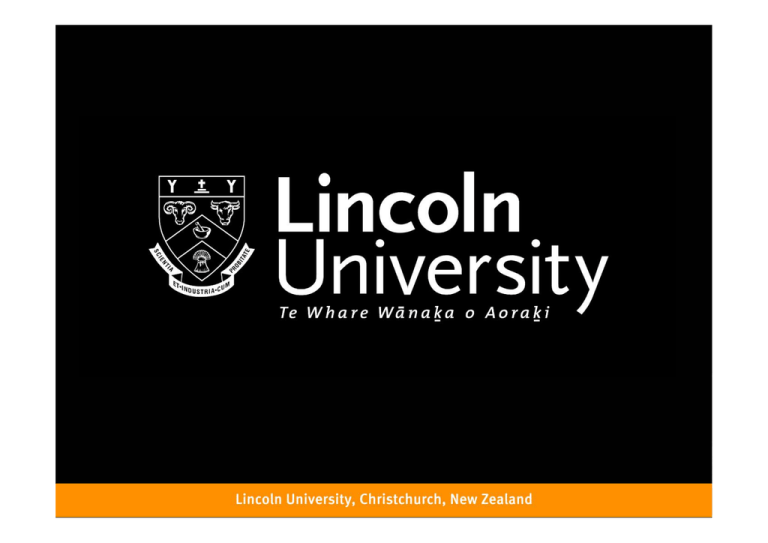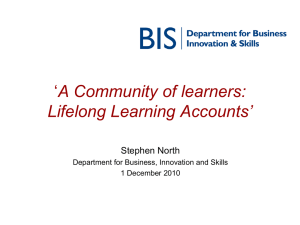Document 12890824
advertisement

Transition from School to Work Paul Dalziel Professor of Economics Details This PowerPoint presentation accompanied a session taken by Professor Paul Dalziel at the Careers Advisers Extravaganza hosted by Lincoln University at the Bert Sutcliffe Pavilion on 1 - 2 March 2007. Introduction • In this session I want to talk about ‘the big picture’ behind careers education in New Zealand. – Why is careers education important? – How is it changing? – What does it mean for young people ‘in transition’ from school to work? – What does it mean for their careers educators? Who am I to talk about this? • I have been involved in research on New Zealand economic and social policy for 25 years. • I am involved in a FRST research proposal on education-employment linkages: – Paul Dalziel (regional economic development) – Jane Higgins (sociology of youth in transition) – Karen Vaughan (careers education, NZCER) – Hazel Phillips (Māori and Pacific education, He Pārekereke, Victoria University of Wellington) • I am writing the New Zealand country study for an OECD international project on integrating regional development, labour and skills training policies. Source: Statistics New Zealand Dec-05 Dec-04 Dec-03 Dec-02 Dec-01 Dec-00 Dec-99 Dec-98 Dec-97 Dec-96 Dec-95 Dec-94 Dec-93 Dec-92 Dec-91 Dec-90 % of labour force Unemployment Rate in New Zealand 12 10 8 6 4 2 0 Source: Statistics New Zealand Dec-05 Dec-04 Dec-03 Dec-02 Dec-01 Dec-00 Dec-99 Dec-98 Dec-97 Dec-96 Dec-95 Dec-94 Dec-93 Dec-92 Dec-91 Dec-90 % of working age population Participation Rate in the Labour Force 69 68 67 66 65 64 63 62 Skill and Labour Shortages Source: NZIER data, published in the Department of Labour’s Skills in the Labour Market Report, November 2006, p. 2. The importance of career education “As more comprehensive workforce development strategies are created, career development services need to be seen as an essential part of the policies and programs that they include. Career development can increase the efficiency of investments in the education and training of young people… Career development services assist individuals to gain the knowledge, skills, attitudes and behaviours to manage their life, learning and work in self-directed ways … and to make meaningful life choices.” Source: Vision Statement for the Third International Symposium on Career Development and Public Policy, Sydney, 21-24 April 2006. Why think about the big picture? • Over the last four years I have been involved in a series of research reports on the high tech sector in Canterbury. – the electronics industry (e.g. Tait Electronics) – the software industry (e.g. Jade Software) • This nationally important industry cluster in the Canterbury region reports ongoing skill shortages. • The Tertiary Education Commission has funded a four-year project looking at employer demand for skilled workers in the Canterbury high tech sector. • Our most recent research for that project estimates growth in employment over the next five years of 3.6 per cent per annum in the electronics sector and 10.7 per cent per annum in software. Skill shortages in IT is a national issue “The number of employed IT professionals has increased from approximately 8,400 in June 2001 to over 28,000 in June 2006. Employment growth of IT professionals of 27.3% per annum was well above 2.8% growth for all occupations. On average, about 4,000 new IT jobs were created each year between June 2001 and June 2006. … The Department of Labour has assessed the IT professional occupation as experiencing genuine skill shortage.” Source: Department of Labour Job Vacancy Monitoring Programme Report, IT Professionals, December 2006. Number of IT Vacancies (New Zealand) 1000 900 800 700 600 500 400 300 200 100 0 Dec 2003 Dec 2004 Dec 2005 Source: Department of Labour Job Vacancy Monitor, December 2006. Dec 2006 Technology teacher courses scrapped Arwen Hann Education Reporter The scrapping of technology courses at Canterbury University’s College of Education this year will add to the desperate shortage of technology teachers, union leaders say. The college has stopped running technology options for trainee teachers this year after receiving no applications for the course. There is a shortage of teachers of home economics, woodwork and metalwork. Dean of secondary education, Neil Lancaster, said the college was disappointed it had to stop the course. “We are disappointed, but there was just no demand in this area and it was not viable,” he said. “We are all too aware of the shortage of technology teachers, but there are no real pathways for people to follow. “Providers are not interested in setting up a course which they don’t think anyone will sign up for. There are many reasons why people don’t choose technology as a teaching career.” Post-Primary Teachers’ Association (PPTA) national executive member, Penney Dunckley, said trainees were put off technology because of pay and status issues. “There is a problem because without a degree teachers cannot progress far in this area, and those with degrees or in the trades can find better work elsewhere,” she said. An Education Ministry staffing survey last year showed technology vacancies made up nearly 20 per cent of all teaching vacancies in secondary schools. A PPTA survey released as part of a report into the sector last year found 62% of schools that responded had difficulty recruiting technology teachers. Technology is recognised by the ministry as an area of teacher shortage, and grants for graduates committed to teaching technology are offered by TeachNZ. Christchurch Press, 29 January 2007, p. A2. In Summary • We have a nationally important industry cluster in the Canterbury region, which reports strong employment growth and ongoing skill shortages. • This is matched nationally, not just locally. • But there is no interest from teacher trainees to enrol in technology courses, and so the courses are dropped. • So we need to think about the whole regional development, labour market, and skills and training systems fit together. • Career educators are an important part of the overall integrating system. Taking a System View Managing the Information s titeies ebrssi Parents nive UW B Joroc b hu Ad re s s Po S lyta etcisExpos Career hti ta Information Dnacicss There is a lot of evidence that many young people feel swamped by the information they are given about career planning. Some school career educators may also feel swamped by the information they are given about career planning! Four Types of Responses • The Hopeful Reactors (14%) – “I’m not going to end up a bum.” • The Confident Explorers (29%) – “I’m creating my self for my future.” • The Passion Honers (34%) – “I’m becoming something in a secure career.” • The Anxious Seekers (24%) – “I don’t know which way to turn.” Source: NZCER, Young People Producing Careers and Identities, June 2006. Challenges for Career Management • The problem today is not so much that students lack information – there is lots of information! • The challenge is to help students (especially the anxious seekers) learn how to make choices that are good for them, not just once but as they grow in their career. • A large amount of the ‘glossy’ information is produced by tertiary educators (universities, polytechnics, wānanga, PTEs), not by employers or independent analysts – so how do we help students evaluate that information? Challenges for Career Management • Internationally, the buzz words now are ‘career management’ rather than ‘career advice’. • How does further education lead to better jobs, but also how do certain jobs lead to further education? – Life-long learning and on-the-job training are important • How can we help a student think about how current choices might affect future choices? • Work-Life Balance. – Work is not simply a means for earning income but is important to individual identity, development and well-being. The Education-Employment Linkages Proposal The aim of the research proposal is to answer the question: How can formal support systems best help young New Zealanders make good education-employment linkages to benefit themselves, their communities, and the national economy? • Effective systems in school communities for helping young New Zealanders make good education-employment linkages. • Effective systems in regional communities for helping young New Zealanders make good education-employment linkages. • Effective systems in Māori and Pacific communities for helping young New Zealanders make good education-employment linkages. • Effective systems for conveying the needs of employers to young New Zealanders, to improve education-employment linkages.








